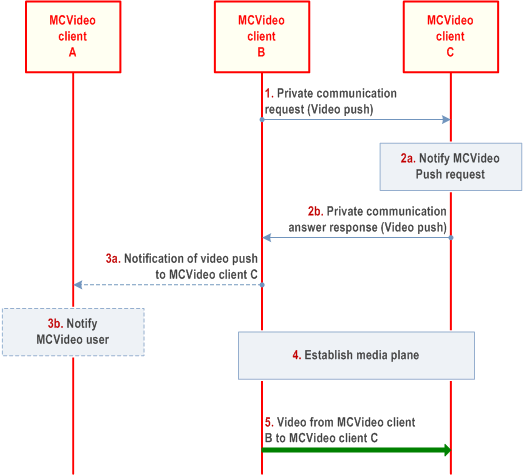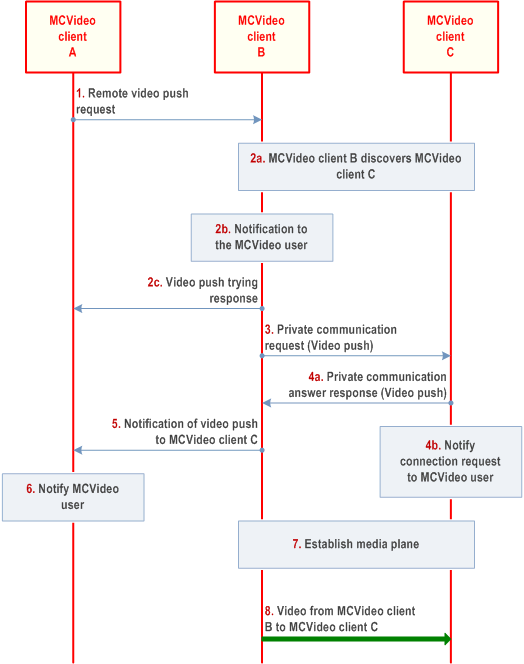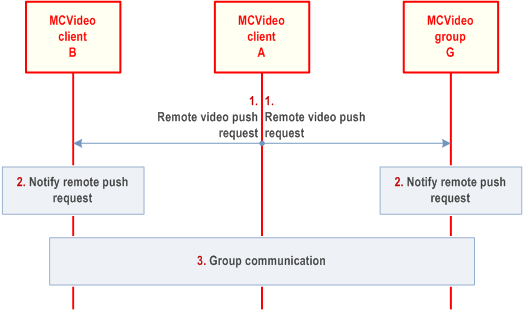Content for TS 23.281 Word version: 19.2.0
1…
5…
6…
7…
7.1.2.3…
7.1.2.3.1.2…
7.1.2.3.2…
7.1.2.4…
7.1.2.5.2…
7.1.3…
7.2…
7.2.2.3…
7.2.2.4…
7.2.3…
7.3…
7.4…
7.4.3…
7.5…
7.5.2.3…
7.6…
7.7…
7.7.1.3…
7.7.1.3.2A…
7.7.1.3.4…
7.7.1.3.6…
7.7.2…
7.7.2.7…
7.7.2.9…
7.8…
7.11…
7.17…
7.19…
7.19.2.8…
7.19.3…
7.19.3.1.4…
7.19.3.2…
7.19.3.2.3…
7.19.3.2.6…
A…
7.4.3 Off-network video push
7.4.3.1 General
7.4.3.2 Information flows for off-network video push
7.4.3.2.1 Remote video push request
7.4.3.2.2 Video push trying response
7.4.3.2.3 Notification of video push
7.4.3.3 Video push to another MCVideo user
7.4.3.3.1 General
7.4.3.3.2 Procedure
7.4.3.4 Remotely initiated video push
7.4.3.4.1 General
7.4.3.4.2 Procedure
7.4.3.5 Remotely initiated video push to a group
7.4.3.5.1 General
7.4.3.5.2 Procedure
...
...
7.4.3 Off-network video push p. 105
7.4.3.1 General p. 105
A MCVideo user triggers its MCVideo client to push a video to another MCVideo client.
A MCVideo user triggers its MCVideo client to trigger a remote video push, which requests a second MCVideo client to push a video to a third MCVideo client or to a MCVideo group.
Off-network remote video push works without involving the network.
Off-network video push communications are based on ProSe capabilities as described in clause 7.18.
7.4.3.2 Information flows for off-network video push p. 105
7.4.3.2.1 Remote video push request p. 105
Table 7.4.3.2.1-1 describes the information flow for the remote video push request sent from one MCVideo client to other MCVideo client(s).
| Information Element | Status | Description |
|---|---|---|
| MCVideo ID | M | The identity of the MCVideo user remotely requesting the video push |
| MCVideo ID | M | The identity of the MCVideo user from whom the video push is requested |
| Video information | O | Information identifying the video |
| MCVideo group ID | O | The MCVideo group ID to which the video is to be transmitted. |
7.4.3.2.2 Video push trying response p. 105
Table 7.4.3.2.2-1 describes the information flow for the video push trying response sent from one MCVideo client to another MCVideo client.
| Information Element | Status | Description |
|---|---|---|
| MCVideo ID | M | The identity of the MCVideo user sending the trying response |
| MCVideo ID | M | The identity of the MCVideo user to whom the trying response is sent |
| MCVideo ID | M | The identity of the MCVideo user to whom the video is attempted |
7.4.3.2.3 Notification of video push p. 105
Table 7.4.3.2.3-1 describes the information flow for the notification of video push sent from one MCVideo client to another MCVideo client.
| Information Element | Status | Description |
|---|---|---|
| MCVideo ID | M | The identity of the MCVideo user sending the notification |
| MCVideo ID | M | The identity of the MCVideo user to whom the notification is sent |
| MCVideo ID | M | The identity of the MCVideo user to whom the video is pushed |
7.4.3.3 Video push to another MCVideo user p. 106
7.4.3.3.1 General p. 106
The MCVideo Push is the capability of a MCVideo user to push a video to another MCVideo user. A MCVideo user can push a video which is:
- being received by the MCVideo user from another a MCVideo client; or
- being recorded live on the MCVideo client.
7.4.3.3.2 Procedure p. 106
Figure 7.4.3.3.2-1 describes procedures for an off-network MCVideo video push, inititated by MCVideo client B with another MCVideo client C, to push a video received from MCVideo client A to MCVideo client C.
MCVideo client A or MCVideo client C or both can be autonomous MCVideo clients or can be human controlled MCVideo clients. In any such combination, following the procedure is followed.
MCVideo client A and MCVideo client B may belong to the same MCVideo user.
Pre-conditions:
- MCVideo client A and MCVideo client B are engaged in MCVideo communication, where MCVideo client B is receiving media from MCVideo client A.
- MCVideo user B has initiated MCVideo video push with MCVideo user C.
- MCVideo client B and MCVideo client C are members of the same ProSe Discovery group and are ProSe 1:1 direct communication capable.
- MCVideo client B has discovered MCVideo client C in proximity, associated with MCVideo user C, using ProSe Discovery procedures.

Step 1.
The MCVideo client B sends a Private communication request towards MCVideo client C. The Private communication request indicates that the request is for video push and contains the SDP offer.
Step 2a.
The MCVideo client C may notify the MCVideo user C about the MCVideo Push request (if the MCVideo client C is human controlled)
Step 2b.
The MCVideo client C automatically accepts the Private communication request for video push and sends a Private communication answer response to MCVideo client B. The Private communication answer response contains SDP answer.
Step 3a.
If configured, the MCVideo client B notifies MCVideo client A about the video being pushed to MCVideo client C by sending a notification message to MCVideo client A.
Step 3b.
If configured, the MCVideo client A may notify the MCVideo user A about the video being pushed to MCVideo client C.
Step 4.
The MCVideo client B and MCVideo client C establish the media plane for communication.
Step 5.
Video being received by MCVideo client B from MCVideo client A is transmitted from MCVideo client B to MCVideo client C and presented to the MCVideo user C.
7.4.3.4 Remotely initiated video push p. 107
7.4.3.4.1 General p. 107
The MCVideo push is the capability of a MCVideo user to push a video from a second MCVideo user to a third MCVideo user.
7.4.3.4.2 Procedure p. 107
Figure 7.4.3.4.2-1 describes procedures for a remotely initiated off-network MCVideo video push, inititated by MCVideo user A at MCVideo client A with another MCVideo client B, to push a video to MCVideo client C.
MCVideo client B can be an autonomous MCVideo client or can be a human controlled MCVideo client. In either case, following procedure is followed.
Pre-conditions:
- MCVideo user A has remotely initiated MCVideo video push with MCVideo user B.
- MCVideo client A and MCVideo client B are members of the same ProSe Discovery group and are ProSe 1:1 direct communication capable.
- MCVideo client A has discovered MCVideo client B in proximity, associated with MCVideo user B, using ProSe Discovery procedures.

Step 1.
The MCVideo client A sends a Video push request towards the MCVideo client B. The Video push request indicates MCVideo client C as the intended recipient.
Step 2a.
The MCVideo client B checks whether there is on-going priviate communication with MCVideo client C. If there is on-going private communication with MCVideo client C, then step 3, step 4 and step 5 are skipped, else MCVideo client B enables ProSe layer to discover MCVideo client C as specified in subclause 7.2.3.
Step 2b.
The MCVideo client B notifies the MCVideo user B about the incoming Video push request (if MCVideo client B is human controlled).
Step 2c.
The MCVideo client B sends a video push trying response to MCVideo client A indicating that it is attempting to establish a connection with MCVideo client C,
Step 3.
Once the required details of MCVideo client C are obtained (either by discovery or from MCVideo client A) the MCVideo client B accepts the Video push request, and sends a Private communication request to MCVideo client C. The Private communication request indicates that the request was in response to the video push request from the MCVideo client A. The Private communication request contains the SDP offer.
Step 4a.
MCVideo client C sends a Private communication answer response to MCVideo client B in response to the Private communication request. The Private communication answer response contains the SDP answer.
Step 4b.
The MCVideo client C notifies MCVideo user C about the incoming Private communication request as an indication of incoming video.
Step 5.
Upon receiving a Private communication answer response from the MCVideo client C, the MCVideo client B sends a notification message to the MCVideo client A indicating that MCVideo client C has accepted the request.
Step 6.
MCVideo client A notifies the MCVideo user A about the acceptance of the request by MCVideo client C (if the MCVideo client A is human controlled)
Step 7.
The MCVideo client B and the MCVideo client C establish the media plane for communication.
Step 8.
Media is transmitted from MCVideo client B to MCVideo client C and presented to the MCVideo user C.
7.4.3.5 Remotely initiated video push to a group p. 109
7.4.3.5.1 General p. 109
The MCVideo push is the capability of a MCVideo user to push a video from a second MCVideo user to a MCVideo group.
7.4.3.5.2 Procedure p. 109
Figure 7.4.3.5.2-1 describes procedures for an off-network remote video push request, initiated by MCVideo user A at MCVideo client A towards a MCVideo client B, to initiate a video push to MCVideo group G.
MCVideo client B can be an autonomous MCVideo client or can be a human controlled MCVideo client. In either case, following procedure should be followed.
Pre-conditions:
- MCVideo client A and MCVideo client B are members of MCVideo group G.
- MCVideo user A has initiated remote video push request with MCVideo user B to initiate a video push to MCVideo group G.

Step 1.
MCVideo client A sends a remote video push request towards the MCVideo group. The remote video push request indicates MCVideo client B as the intended target of the request and MCVideo group G as the intended recipient.
Step 2.
Upon receiving the remote video push request as the intended target of the request, the MCVideo client B notifies the MCVideo user B of the remote video push request, if the MCVideo client B is human controlled. Other MCVideo group members notify their respective MCVideo users of the remote video push request.
Step 3.
The MCVideo client B automatically accepts the remote video push request and sends a group communication announcement message with video push indication towards the MCVideo group, as described in subclause 7.1.3.3. The group communication announcement message contains an SDP body and an indication that the group communication announcement is for video push.